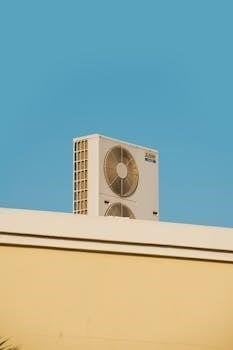Mitsubishi Air Conditioning Unit Manual⁚ A Comprehensive Guide
Welcome to your comprehensive guide to understanding your Mitsubishi Air Conditioning Unit Manual․ This resource provides essential information for optimal use, maintenance, and troubleshooting․ Ensure long-lasting performance by following provided instructions․
Finding the Right Manual
Locating the correct manual for your Mitsubishi Electric air conditioning unit is crucial for proper operation and maintenance․ Start by identifying the model number, typically found on the unit itself or on your purchase documentation․ Once you have the model number, visit the Mitsubishi Electric website and navigate to the support or manuals section․
Here, you can enter the model number to search for the specific manual; Alternatively, browse through the available manuals, filtering by product type․ Many online databases also host Mitsubishi air conditioner manuals, so utilize search engines with specific keywords like “Mitsubishi [Model Number] manual․” Ensure the manual matches your unit for accurate information․

Understanding Your Mitsubishi Air Conditioner
This section provides insights into Mitsubishi Electric air conditioning systems, helping you understand their features and benefits․ Learn about the technology and design that make them efficient․
Overview of Mitsubishi Electric Air Conditioning Systems
Mitsubishi Electric stands as a world leader in air conditioning, offering an extensive range of solutions tailored to diverse needs․ Their systems are designed for both residential and commercial applications, ensuring optimal comfort and efficiency․ From wall-mounted units to fully ducted systems, Mitsubishi Electric provides flexibility and innovation․ Their commitment to quality and performance is evident in every product․ Known for energy efficiency and reliability, Mitsubishi Electric air conditioners offer long-lasting performance․ Explore their range of heat pumps, Lossnay recovery ventilation, and hot water heat pumps for comprehensive climate control solutions․ Discover why Mitsubishi Electric is a trusted name in air conditioning․
Types of Units⁚ Split Systems, Multi-Splits, and More
Mitsubishi Electric offers a variety of air conditioning units to suit different needs and spaces․ Split systems are ideal for individual rooms, providing efficient cooling and heating․ Multi-split systems allow you to connect multiple indoor units to a single outdoor unit, offering zoned climate control․ These systems are perfect for homes or offices with varying temperature preferences․ Beyond these, Mitsubishi Electric provides options like floor-standing units and fully ducted air conditioning solutions․ Each type ensures flexibility to meet challenging air conditioning demands․ Explore the range to find the perfect fit for your specific requirements, balancing performance, efficiency, and comfort․ Consider the unique benefits of each system․
Safety Precautions and Important Information
Prioritize safety by adhering to all precautions outlined in your Mitsubishi air conditioning unit manual․ This section highlights vital guidelines and warnings to ensure safe operation and prevent potential hazards․
General Safety Guidelines
Before operating your Mitsubishi air conditioner, carefully review these general safety guidelines․ Always ensure the power is shut off before performing any maintenance or cleaning․ Avoid using extension cords or connecting multiple devices to a single outlet․ If refrigerant leakage occurs, prevent contact with fire to avoid harmful gas or fire risks․ Keep the area around the units clear of obstructions․ Read the operating instructions thoroughly for safe and correct use․ Store the manual in a safe place for future reference․ These precautions are crucial for your safety and the longevity of your air conditioner․
Refrigerant Leakage and Fire Hazards
Refrigerant leakage poses significant fire hazards if it comes into contact with open flames or heating elements, potentially creating harmful gases․ Should you detect a refrigerant leak, immediately turn off the air conditioner and ventilate the area thoroughly․ Do not operate the unit until the leak is repaired by a qualified technician․ Never attempt to repair refrigerant leaks yourself, as this requires specialized equipment and knowledge․ Always prioritize safety by keeping flammable materials away from the air conditioning units․ Ensure proper ventilation to mitigate risks associated with refrigerant exposure․ Follow all safety guidelines to prevent accidents․

Operation and Usage
This section details the proper operation and usage of your Mitsubishi air conditioner․ Learn about basic functions, remote control features, and optimal settings for efficient and comfortable climate control․
Basic Operation Instructions
To begin, ensure the unit is properly connected to a power source․ Consult the user manual for specific voltage requirements․ Next, power on the unit using the power button on either the unit itself or the remote control․ Select your desired operating mode⁚ cooling, heating, fan, or auto, depending on your model․ Adjust the temperature setting to your preference using the up and down arrows․ Control the fan speed for airflow․
Refer to the manual for advanced features like timers and energy-saving modes․ Remember to regularly clean the filters for optimal performance․ If you encounter any issues, consult the troubleshooting section․
Remote Control Symbols and Functions
Understanding the remote control is key to maximizing your Mitsubishi air conditioner’s potential; The power symbol, often a circle with a line, turns the unit on or off․ Mode symbols indicate cooling (snowflake), heating (sun), fan (propeller), and auto (A)․ Temperature adjustment uses up/down arrows․
Fan speed is typically represented by a fan icon with varying levels․ Timer symbols often resemble a clock, enabling scheduled operation․ Swing or vane symbols control airflow direction․ Eco mode, usually a leaf, optimizes energy consumption․ Consult your manual for specific symbols related to specialized functions․

Installation Guide (For Installers)
This section is specifically tailored for professional installers․ It provides detailed, step-by-step instructions for the correct installation of Mitsubishi air conditioning systems, ensuring optimal performance and safety compliance․
Pre-Installation Checklist
Before commencing any installation work, it is crucial to complete this pre-installation checklist to ensure a smooth and safe setup․ Verify that all required components are present and undamaged, including the indoor unit, outdoor unit, refrigerant piping, and wiring․ Confirm the correct voltage and electrical supply compatibility with the air conditioning system․ Check the structural integrity of the mounting location for both indoor and outdoor units, ensuring they can support the weight․ Ensure sufficient clearance around the outdoor unit for adequate airflow and maintenance access․ Review local building codes and regulations regarding air conditioning installations․ Have the appropriate tools and safety equipment available, such as refrigerant gauges, vacuum pump, and personal protective gear․ Double-check the refrigerant type specified for the unit and ensure compatibility․ Finally, consult the installation manual for model-specific requirements and precautions․
Step-by-Step Installation Procedures
Follow these step-by-step installation procedures for a successful setup, beginning with mounting the indoor unit securely to the wall, ensuring proper alignment and stability․ Next, install the outdoor unit on a level surface, providing adequate ventilation and protection from the elements․ Connect the refrigerant piping between the indoor and outdoor units, carefully avoiding kinks or leaks․ Evacuate the refrigerant lines using a vacuum pump to remove air and moisture․ Release the refrigerant charge according to the manufacturer’s specifications․ Connect the electrical wiring, adhering to local codes and safety standards․ Perform a thorough leak test to ensure the system is sealed․ Insulate the refrigerant lines to prevent condensation and energy loss․ Conduct a test run to verify proper operation, checking for cooling, heating, and airflow․ Finally, provide the user with the operation manual and explain basic functions․
Maintenance and Cleaning
Proper maintenance and cleaning are crucial for your Mitsubishi air conditioning unit․ Regular care ensures optimal performance, energy efficiency, and prolongs the lifespan of your system, preventing costly repairs․
Regular Maintenance Tasks
To ensure your Mitsubishi air conditioning unit operates efficiently and reliably, regular maintenance is essential․ This includes cleaning or replacing air filters every few weeks, depending on usage and environmental conditions․ Inspect the outdoor unit for debris, such as leaves and branches, and clear any obstructions․ Check the condensate drain line to prevent clogs that can lead to water damage․ Periodically inspect the electrical connections for any signs of damage or corrosion․ It’s also advisable to schedule professional servicing annually to ensure thorough cleaning, inspection, and calibration of the unit․ Regular attention to these tasks will maximize the lifespan and performance of your air conditioner․
Cleaning Procedures for Indoor and Outdoor Units
Maintaining the cleanliness of your Mitsubishi air conditioning unit, both indoors and outdoors, is critical for optimal performance․ For the indoor unit, regularly clean the air filters with mild soap and water, ensuring they are completely dry before reinstallation․ Gently wipe down the unit’s exterior with a soft, damp cloth․ The outdoor unit requires removing any accumulated debris, such as leaves, dirt, or snow․ Use a garden hose with a gentle spray to clean the fins, taking care not to damage them․ Ensure the power is turned off before any cleaning․ Professional cleaning services can provide a deeper clean for both units․

Troubleshooting
Encountering issues with your Mitsubishi AC unit? This section offers solutions to common problems․ Learn to diagnose and resolve minor issues, ensuring efficient operation․ Know when professional help is necessary․
Common Issues and Solutions
Addressing common problems with your Mitsubishi air conditioner can save time and money․ If your unit isn’t cooling effectively, check the air filter first; a dirty filter restricts airflow․ Ensure the thermostat is set correctly and the unit is in the appropriate mode (cooling or heating)․
Another frequent issue is water leakage; this can be caused by a clogged drain line․ Inspect the outdoor unit for debris that might obstruct airflow․ If the unit makes unusual noises, such as rattling or buzzing, it could indicate loose parts or a failing component․ Refer to the user manual for error codes and their corresponding solutions․ Resetting the system by turning it off and on again can sometimes resolve minor glitches․ Remember to consult the manual for specific troubleshooting steps related to your model․
When to Call a Technician
Knowing when to seek professional help for your Mitsubishi air conditioner is crucial for safety and preventing further damage․ If you notice refrigerant leaks, a strong chemical odor, or hear hissing sounds, immediately turn off the unit and call a qualified technician․ Refrigerant leaks pose environmental and health hazards, requiring specialized handling․
Electrical issues, such as frequent tripping of circuit breakers or sparking, also warrant immediate professional attention․ Never attempt to repair electrical components yourself․ If the air conditioner fails to respond after troubleshooting basic issues like filter replacement and thermostat adjustments, a technician can diagnose complex problems․ Unusual noises, persistent odors, or a complete system failure are all signs that it’s time to consult a professional․ Regular maintenance by a qualified technician can also help prevent major breakdowns․
